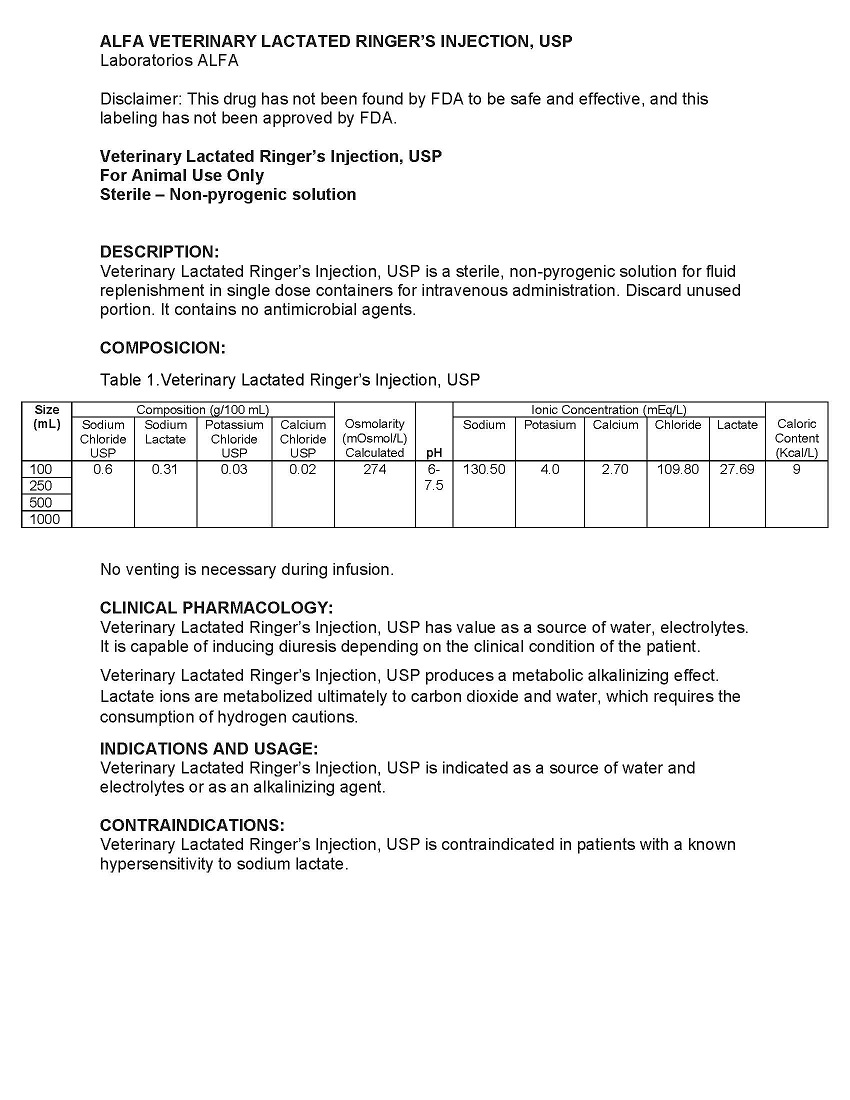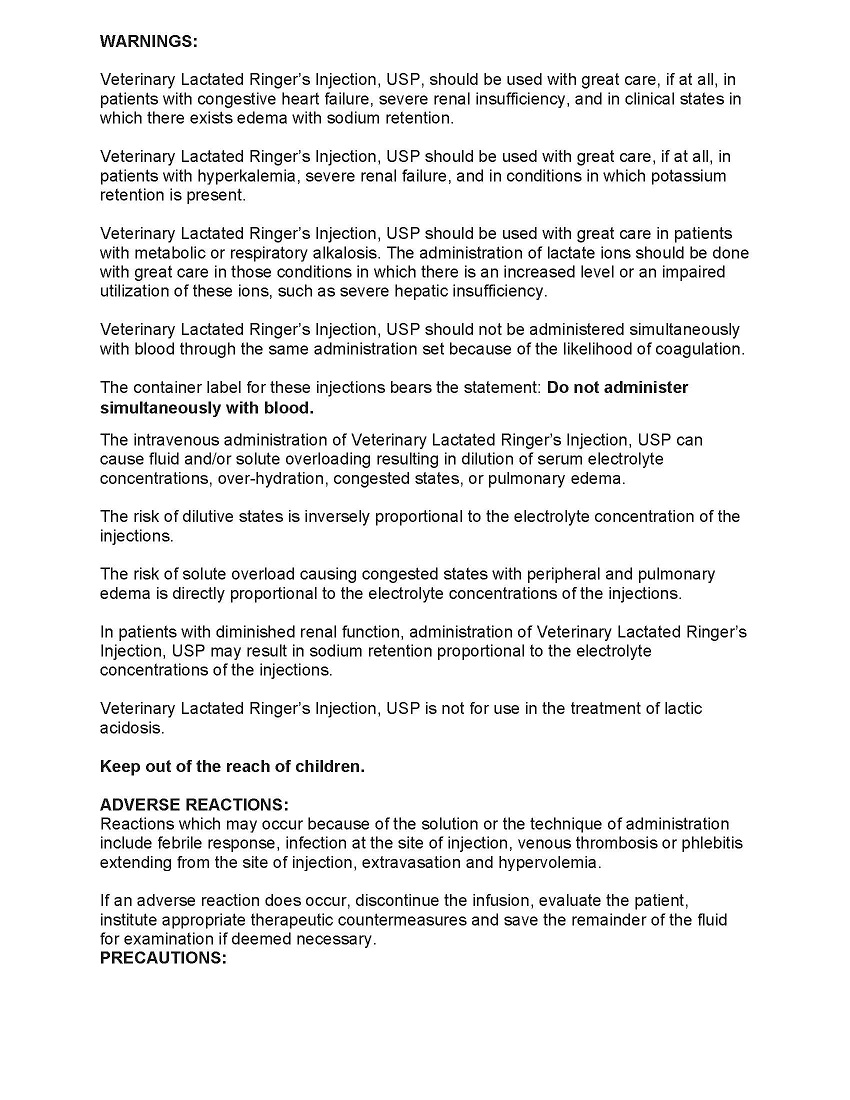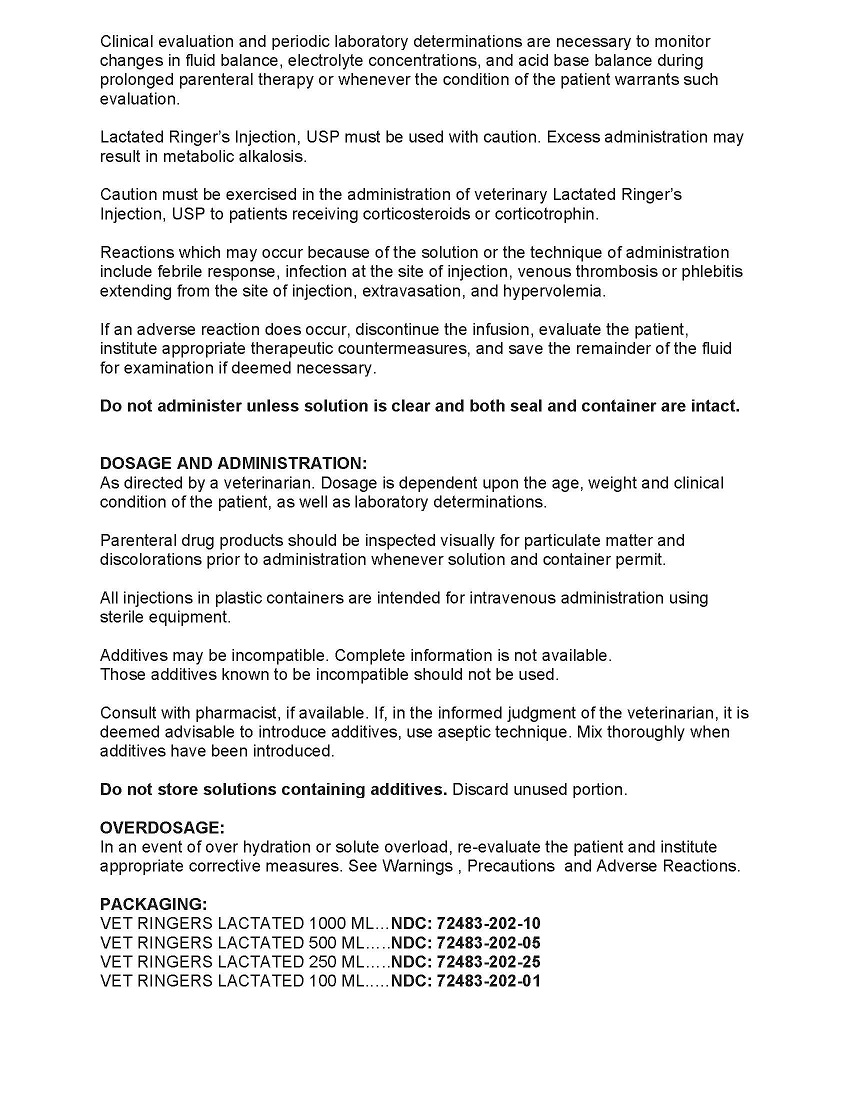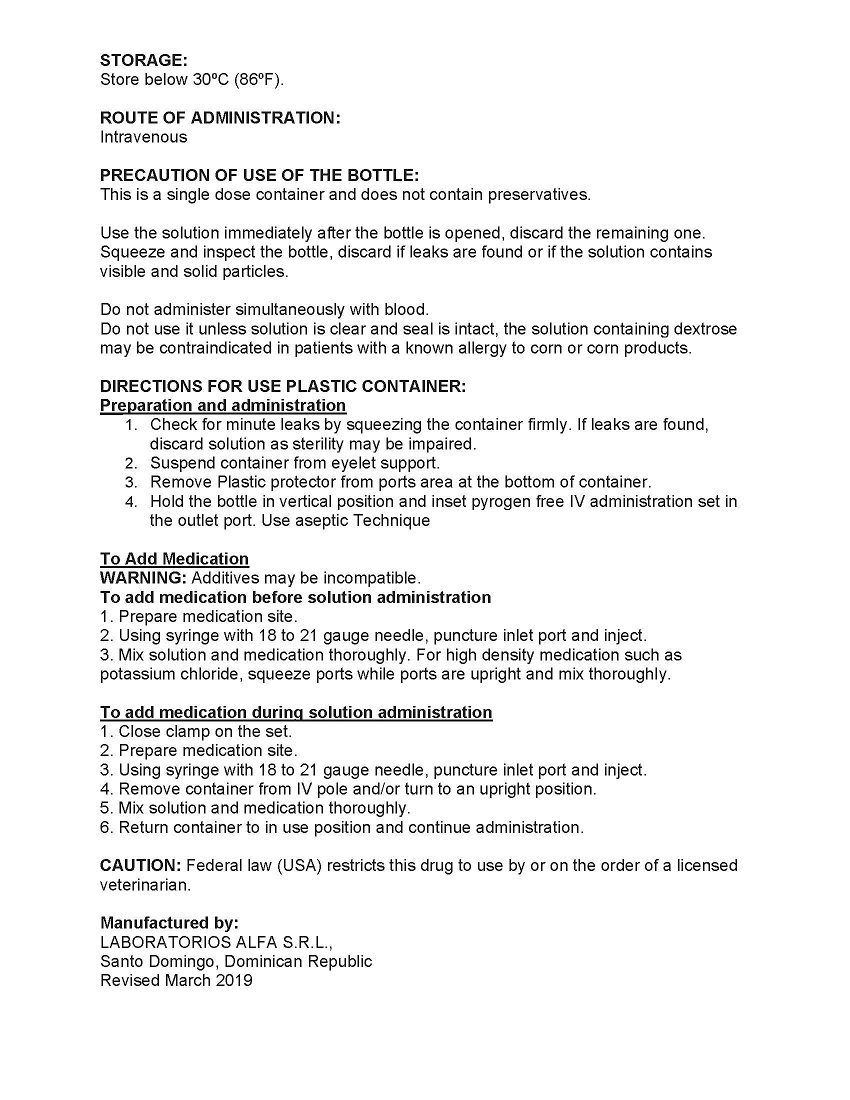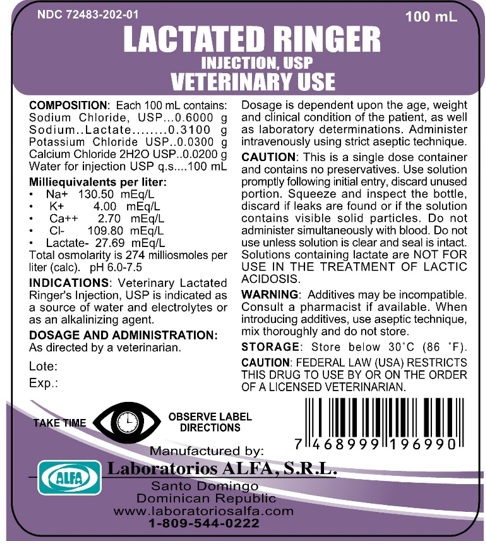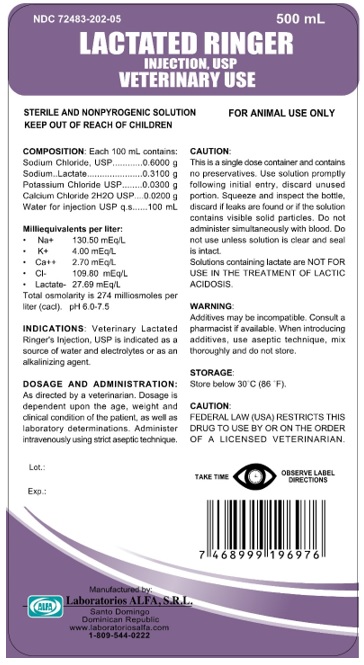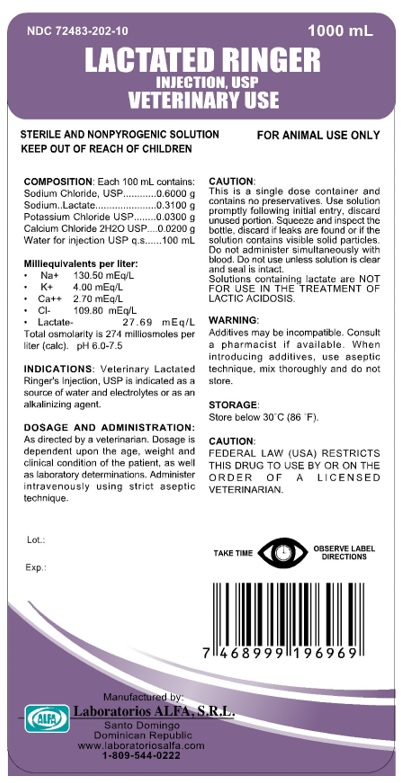ALFA VETERINARY LACTATED RINGERS- lactated ringers sodium chloride,sodium lactate, potassium chloride,calcium chloride injection, solution
Alfa Veterinary Lactated Ringers by
Drug Labeling and Warnings
Alfa Veterinary Lactated Ringers by is a Animal medication manufactured, distributed, or labeled by Laboratorios Alfa SRL. Drug facts, warnings, and ingredients follow.
Drug Details [pdf]
-
DESCRIPTION
Veterinary Lactated Ringers Injection, USP is a sterile, non-pyrogenic solution for fluid replenishment
in single dose containers for intravenous administration. Discard unused portion. It contains no antimicrobial agents.
Table 1.Veterinary Lactated Ringers Injection, USP Size mL Composition (g/100 mL) Osmolarity
(mOsmol/L)
CalculatedpH Ionic Concentration (mEq/L) Caloric
Content
(Kcal/L)Sodium Chloride
USPSodium Lactate Potassium
Chloride
USPCalcium
Chloride
USPSodium Potasium Calcium Chloride Lactate 100 0.6 0.31 0.03 0.02 274 6-7.5 130.50 4.0 2.70 109.80 27.69 9 250 500 1000 No venting is necessary during infusion.
-
CLINICAL PHARMACOLOGY
Veterinary Lactated Ringer’s Injection, USP has value as a source of water, electrolytes. It is capable of inducing diuresis depending on the clinical condition of the patient.
Veterinary Lactated Ringer’s Injection, USP produces a metabolic alkalinizing effect. Lactate ions are metabolized ultimately to carbon dioxide and water, which requires the consumption of hydrogen cautions.
- INDICATIONS AND USAGE
- CONTRAINDICATIONS
-
WARNINGS
Veterinary Lactated Ringer’s Injection, USP, should be used with great care, if at all, in patients with congestive heart failure, severe renal insufficiency, and in clinical states in which there exists edema with sodium retention.
Veterinary Lactated Ringer’s Injection, USP should be used with great care, if at all, in patients with hyperkalemia, severe renal failure, and in conditions in which potassium retention is present.
Veterinary Lactated Ringer’s Injection, USP should be used with great care in patients with metabolic or respiratory alkalosis. The administration of lactate ions should be done with great care in those conditions in which there is an increased level or an impaired utilization of these ions, such as severe hepatic insufficiency.
Veterinary Lactated Ringer’s Injection, USP should not be administered simultaneously with blood through the same administration set because of the likelihood of coagulation.
The container label for these injections bears the statement: Do not administer simultaneously with blood.
The intravenous administration of Veterinary Lactated Ringer’s Injection, USP can cause fluid and/or solute overloading resulting in dilution of serum electrolyte concentrations, over-hydration, congested states, or pulmonary edema.
The risk of dilutive states is inversely proportional to the electrolyte concentration of the injections.
The risk of solute overload causing congested states with peripheral and pulmonary edema is directly proportional to the electrolyte concentrations of the injections.
In patients with diminished renal function, administration of Veterinary Lactated Ringer’s Injection, USP may result in sodium retention proportional to the electrolyte concentrations of the injections.
Veterinary Lactated Ringer’s Injection, USP is not for use in the treatment of lactic acidosis
Keep out of the reach of children.
-
ADVERSE REACTIONS
Reactions which may occur because of the solution or the technique of administration include febrile response, infection at the site of injection, venous thrombosis or phlebitis extending from the site of injection, extravasation and hypervolemia.
If an adverse reaction does occur, discontinue the infusion, evaluate the patient, institute appropriate therapeutic countermeasures and save the remainder of the fluid for examination if deemed necessary.
-
PRECAUTIONS
Clinical evaluation and periodic laboratory determinations are necessary to monitor changes in fluid balance, electrolyte concentrations, and acid base balance during prolonged parenteral therapy or whenever the condition of the patient warrants such evaluation.
Lactated Ringer’s Injection, USP must be used with caution. Excess administration may result in metabolic alkalosis.
Caution must be exercised in the administration of veterinary Lactated Ringer’s Injection, USP to patients receiving corticosteroids or corticotrophin.
Reactions which may occur because of the solution or the technique of administration include febrile response, infection at the site of injection, venous thrombosis or phlebitis extending from the site of injection, extravasation, and hypervolemia.
If an adverse reaction does occur, discontinue the infusion, evaluate the patient, institute appropriate therapeutic countermeasures, and save the remainder of the fluid for examination if deemed necessary.Do not administer unless solution is clear and both seal and container are intact.
-
DOSAGE AND ADMINISTRATION
As directed by a veterinarian. Dosage is dependent upon the age, weight and clinical condition of the patient, as well as laboratory determinations.
Parenteral drug products should be inspected visually for particulate matter and discolorations prior to administration whenever solution and container permit.
All injections in plastic containers are intended for intravenous administration using sterile equipment.
Additives may be incompatible. Complete information is not available.
Those additives known to be incompatible should not be used.
Consult with pharmacist, if available. If, in the informed judgment of the veterinarian, it is deemed advisable to introduce additives, use aseptic technique. Mix thoroughly when additives have been introduced.
Do not store solutions containing additives. Discard unused portion.
- OVERDOSAGE
- STORAGE
-
PRECAUTION OF USE OF THE BOTTLE
This is a single dose container and does not contain preservatives.
Use the solution immediately after the bottle is opened, discard the remaining one.
Squeeze and inspect the bottle, discard if leaks are found or if the solution contains visible and solid particles.Do not administer simultaneously with blood.
Do not use it unless solution is clear and seal is intact, the solution containing dextrose may be contraindicated in patients with a known allergy to corn or corn products.DIRECTIONS FOR USE PLASTIC CONTAINER:
Preparation and administration
1. Check for minute leaks by squeezing the container firmly. If leaks are found, discard solution as sterility may be impaired.
2. Suspend container from eyelet support.
3. Remove Plastic protector from ports area at the bottom of container.
4. Hold the bottle in vertical position and inset pyrogen free IV administration set in the outlet port. Use aseptic TechniqueTo Add Medication
WARNING: Additives may be incompatible.
To add medication before solution administration
1. Prepare medication site.
2. Using syringe with 18 to 21 gauge needle, puncture inlet port and inject.
3. Mix solution and medication thoroughly. For high density medication such as potassium chloride, squeeze ports while ports are upright and mix thoroughly.To add medication during solution administration
1. Close clamp on the set.
2. Prepare medication site.
3. Using syringe with 18 to 21 gauge needle, puncture inlet port and inject.
4. Remove container from IV pole and/or turn to an upright position.
5. Mix solution and medication thoroughly.
6. Return container to in use position and continue administration.CAUTION: Federal law (USA) restricts this drug to use by or on the order of a licensed veterinarian.
- Package Insert
- PRINCIPAL DISPLAY PANEL
-
INGREDIENTS AND APPEARANCE
ALFA VETERINARY LACTATED RINGERS
lactated ringers sodium chloride,sodium lactate, potassium chloride,calcium chloride injection, solutionProduct Information Product Type PRESCRIPTION ANIMAL DRUG Item Code (Source) NDC: 72483-202 Route of Administration INTRAVENOUS Active Ingredient/Active Moiety Ingredient Name Basis of Strength Strength SODIUM CHLORIDE (UNII: 451W47IQ8X) (CHLORIDE ION - UNII:Q32ZN48698) SODIUM CHLORIDE 600 mg in 100 mL SODIUM LACTATE (UNII: TU7HW0W0QT) (LACTIC ACID - UNII:33X04XA5AT) SODIUM LACTATE 310 mg in 100 mL POTASSIUM CHLORIDE (UNII: 660YQ98I10) (POTASSIUM CATION - UNII:295O53K152) POTASSIUM CATION 30 mg in 100 mL CALCIUM CHLORIDE (UNII: M4I0D6VV5M) (CALCIUM CATION - UNII:2M83C4R6ZB) CALCIUM CHLORIDE 20 mg in 100 mL Packaging # Item Code Package Description Marketing Start Date Marketing End Date 1 NDC: 72483-202-10 1000 mL in 1 BOTTLE, PLASTIC 2 NDC: 72483-202-05 500 mL in 1 BOTTLE, PLASTIC 3 NDC: 72483-202-24 250 mL in 1 BOTTLE, PLASTIC 4 NDC: 72483-202-01 100 mL in 1 BOTTLE, PLASTIC Marketing Information Marketing Category Application Number or Monograph Citation Marketing Start Date Marketing End Date unapproved drug other 12/29/2019 Labeler - Laboratorios Alfa SRL (815941244)
© 2025 FDA.report
This site is not affiliated with or endorsed by the FDA.
